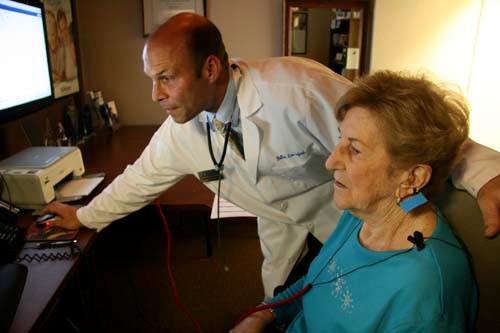
These aren’t your grandfather’s hearing aids.
Thanks to giant advances in technology, wearing hearing aids today is not emotionally or physically traumatizing.
Beltone New England’s newest product line, Beltone True, uses new technology patterned after the ear’s natural ability to hear in multiple environments. The product won recognition in the Health and Wellness category of the 2011 International Consumer Electronics Show’s Design and Engineering Innovation Awards program.
“It’s the first time a hearing aid has ever won in that category,” said Perry Ebel, vice president of business development for Beltone New England. “And it’s primarily because the product is very sophisticated. The computer chip that is in it is incredibly fast, much faster than anything else that’s been in the industry for a while, and its approach to solving some of the problems in hearing loss is unique and significant.”
For example, a hearing-impaired person who is watching and listening to television may leave the room, and under normal circumstances that might require an adjustment to an aid. But the Beltone True automatically senses the change in environment and adjusts itself comfortably for the wearer.
And while digital hearing aids have been around for many years, it’s just been over the last six years that something called “open technology” has been available, Ebel said.
“In its simplest terms, there was a physics problem,” he said. “About six years ago, hearing aids had to be made so that they blocked all the sound coming into the ear. And the reason that had to happen was because the digital technology involved couldn’t sample the sound it needed to sample for your hearing loss.”
Therefore, the sound could not be delivered to the eardrum at the same time as natural sound. Then advancing computer technology allowed sounds to go into the eardrum along with processed sound at the same time so it didn’t sound mumbled.
For Blanche King, 89, of Smithfield, being high-tech was not the motivation behind her getting the Beltone True. She had never worn hearing aids before but noticed that her hearing was getting increasingly worse and wanted to be able to hear her grandchildren and her church service as well as on the telephone.
She chose the Beltone, not so much for it’s cross-platform capabilities – the nearly invisible Bluetooth hearing aid is among the first to wirelessly receive sound directly from televisions, cellphones, music systems, computers and iPods – but because she got a mailer advertising the device and offering a free hearing test. She is looking forward to watching television with it but she doesn’t own a computer.
“I feel pretty good right now, I can hear,” King said.
The price tag on the hearing aid ranges from $4,400 a pair to $7,000 a pair, depending on a number of different factors, such as extent of hearing loss, the level of the person’s activity and their budget. Most insurance doesn’t cover the devices. That’s why Beltone has given away hearing aids to contest winners for the last five years.
The True has strengthened Beltone New England’s sales. Last year, its first full year in the market, 60 percent of the company’s 13,000 units sold were the new product. And expectations are that sales will only grow from here.
Still, there are impediments to growth. For instance, only one-quarter of the people who would benefit from a hearing aid actually get one, Ebel said, despite the fact that baby boomers, the first generation to be introduced to amplified sounds, as well as Gen Xers and Millenials, listening to cranked up iPods, are experiencing hearing loss at rates not seen before, he said.
As much as the inner workings of the latest generation of hearing aids have changed, the cosmetics have evolved as well.
There are gold hearing aids and some are brightly colored. One company is even exploring making a hearing aid that looks like earrings and another is looking at fake skin to cover the device.
“It’s a marketing thing,” he said. “We deal with a lot of young people with hearing loss and some of [the hearing aids] can look like bling.” •












